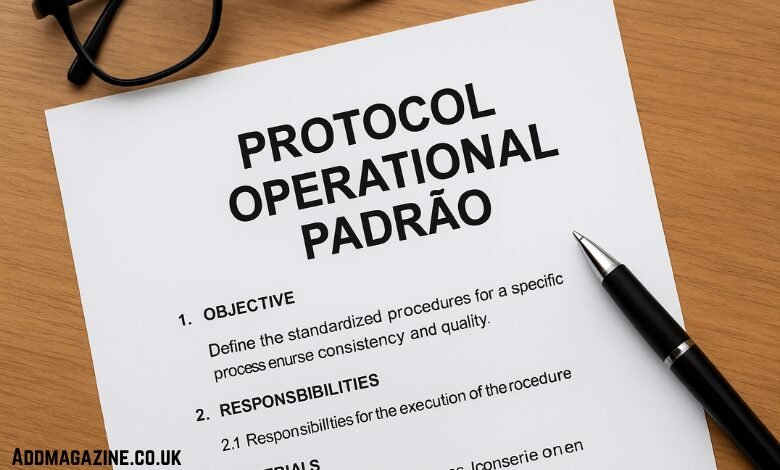Every organization, regardless of its size or sector, faces the challenge of ensuring that daily operations are carried out in a consistent and reliable way. Errors, inefficiencies, and miscommunication often occur when processes are left to individual interpretation. To avoid this, many organizations adopt a structured document known as a Protocolo Operacional Padrão (POP), or in English, Standard Operating Procedure (SOP).
An SOP is not simply a set of instructions. An SOP is an official guide that specifies the task, identifies responsible personnel, and outlines the conditions for execution. By establishing a clear framework, SOPs help companies and institutions maintain quality, ensure compliance with regulations, and reduce risks associated with errors or variability in performance.
This article explores the concept of SOPs in detail: what they are, why they matter, how they are created, where they are applied, and what benefits and challenges they bring.
Why Organizations Use Standard Operating Procedures
Organizations introduce SOPs for several reasons, most of them linked to efficiency, safety, and accountability.
- Consistency in Processes
When multiple people are responsible for the same task, results can vary if there is no fixed guideline. SOPs ensure that the procedure remains the same, regardless of who executes it. - Quality Control
Maintaining product or service quality is essential. SOPs provide measurable steps that align with organizational standards, which makes it easier to monitor and maintain quality. - Training and Onboarding
New employees benefit greatly from SOPs. Instead of relying solely on verbal instructions, organizations provide written procedures that accelerate learning and reduce mistakes during the adaptation phase. - Compliance and Regulation
Many sectors, such as healthcare, pharmaceuticals, and food production, are highly regulated. Many industries and regulations mandate SOPs as a means of demonstrating compliance and meeting legal obligations. - Risk Reduction
A well-designed SOP minimizes risks by identifying potential hazards and specifying safe methods to perform tasks. - Accountability and Documentation
By assigning responsibilities and creating records, SOPs make it easier to track accountability in case of audits, inspections, or investigations.
Core Elements of an SOP
Although SOPs may differ depending on industry or function, most follow a common structure. A typical document includes the following sections:
- Title and Identification
Each SOP begins with a clear title, reference number, version, and approval date. This ensures that employees are working with the most updated document. - Objective
The objective explains the purpose of the SOP. It answers the question: “Why is this procedure necessary?” - Scope
The scope explains the context of use, detailing the areas, situations, and teams that must adhere to the procedure. - Responsibilities
This section identifies the roles or positions responsible for carrying out each step of the procedure. - Materials and Resources
Any equipment, tools, or documents needed for the procedure are listed to avoid omissions. - Procedure
The core of any SOP lies in its sequence of instructions that guide the process from start to finish. They are usually written in clear, simple language and often supported by flowcharts, diagrams, or checklists. - Quality Control and Verification
To ensure compliance, the SOP specifies how results will be measured or verified. This can include inspections, tests, or sign-off requirements. - Records and Documentation
Many SOPs require workers to keep records. These records serve as proof of compliance and can be reviewed during audits. - References and Appendices
Supporting documents, such as legal regulations, technical manuals, or additional guidelines, may be attached to provide context.
How SOPs Are Developed
Developing an SOP goes beyond drafting directions—it requires planning, validation, and alignment with organizational needs. It involves careful planning, consultation, and testing.
- Process Analysis
The first step is to identify which processes need formalization. Processes that directly influence safety, quality, or regulatory compliance are usually given priority when drafting SOPs. - Collaboration with Experts
Input from workers, supervisors, and subject-matter experts is essential. They know the practical details of the process and can identify potential risks. - Drafting the Document
The initial draft includes all necessary sections: objective, scope, responsibilities, and detailed steps. SOPs should use straightforward wording, avoiding technical complexity that could confuse the reader. - Review and Validation
Before implementation, the SOP is reviewed by managers, quality control teams, and sometimes external auditors. Feedback ensures accuracy and compliance with standards. - Training and Implementation
Employees must be trained to understand and apply the SOP. Training sessions, demonstrations, and assessments are common methods. - Monitoring and Updating
SOPs are living documents. Processes evolve, and regulations change, so procedures must be periodically reviewed and updated.
SOPs in Different Sectors
The application of SOPs extends across nearly every industry. The following illustrates how SOPs are applied across different industries and organizational settings.
Healthcare and Hospitals
Hospitals use SOPs to guide everything from patient admissions to medication administration. For instance, a nursing SOP might describe the exact steps for administering intravenous medication, reducing the risk of dosage errors.
Pharmaceuticals and Laboratories
Pharmaceutical companies rely heavily on SOPs because of strict regulatory oversight. Procedures for mixing compounds, testing samples, and storing products are precisely documented to ensure both safety and compliance.
Manufacturing and Industry
In manufacturing, SOPs commonly regulate equipment use, upkeep, and inspection routines, reducing risks and securing consistent production quality.
Food Industry
Food safety regulations require SOPs for handling ingredients, cleaning equipment, and monitoring temperatures. These prevent contamination and protect public health.
Government and Public Services
Government offices use SOPs to guide administrative tasks, such as issuing licenses or managing public records. Standardization ensures that citizens receive equal treatment.
Education and Training
Educational institutions develop SOPs for examinations, student admissions, and laboratory safety. This ensures fairness and minimizes administrative errors.
Benefits of Implementing SOPs
The widespread use of SOPs is evidence of their importance. Some of the key benefits include:
- Improved Efficiency: Workers follow the same path, avoiding time wasted on uncertainty or repeated mistakes.
- Enhanced Safety: By outlining safe practices, SOPs reduce workplace accidents and hazards.
- Regulatory Compliance: Organizations meet legal requirements, avoiding fines or penalties.
- Clear Communication: SOPs eliminate confusion by defining responsibilities and procedures.
- Better Training: New employees adapt faster with written guidance.
- Quality Assurance: Standardization ensures that products and services consistently meet expectations.
- Audit Preparedness: Detailed records and documented procedures provide evidence during inspections.
Challenges and Limitations
Despite their advantages, SOPs are not free from challenges.
- Resistance to Change
Employees may resist new procedures, especially if they feel the old way was more convenient. - Overly Complex Documents
Some SOPs become too technical or lengthy, making them difficult to follow in practice. - Lack of Updates
Outdated SOPs can cause more harm than good. Without regular reviews, they fail to reflect current practices. - Implementation Costs
Developing and training staff on SOPs requires time and resources, which can be a burden for smaller organizations. - Over-Reliance on Procedures
In some cases, strict adherence to SOPs may limit flexibility. Workers may find it difficult to adapt to unexpected situations not covered by the document.
Best Practices for Effective SOPs
To maximize effectiveness, organizations can adopt the following best practices:
- Keep Language Clear: Use simple, direct instructions rather than technical jargon.
- Involve Staff in Development: Workers who follow the procedures should contribute to writing them.
- Use Visual Aids: Diagrams, flowcharts, and checklists improve understanding.
- Train Thoroughly: Proper training ensures that staff know not only what to do but also why it matters.
- Review Regularly: Set a fixed schedule for reviewing and updating SOPs.
- Digitalize When Possible: Storing SOPs in digital systems makes them easier to access and update.
- Balance Detail and Usability: Provide enough information to avoid errors but avoid making the document unnecessarily long.
Conclusion
The Protocolo Operacional Padrão (Standard Operating Procedure) is more than just a written set of instructions. It is a management tool that promotes consistency, ensures compliance, and enhances safety across industries. By carefully designing, implementing, and updating SOPs, organizations can reduce risks, improve training, and maintain high standards of quality.
While challenges exist—such as resistance to change or the cost of implementation—the long-term benefits make SOPs indispensable in both the private and public sectors. In a world where accountability, efficiency, and quality are crucial, the role of SOPs will only grow stronger.




